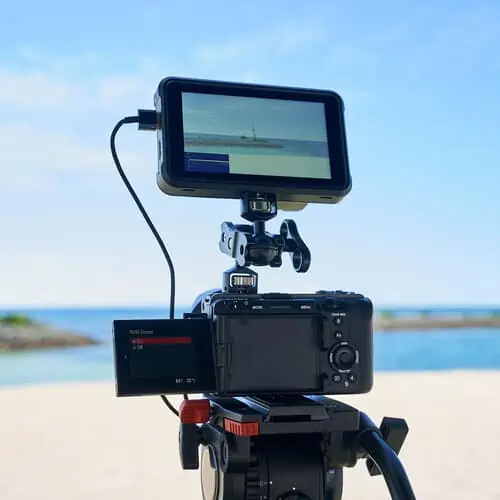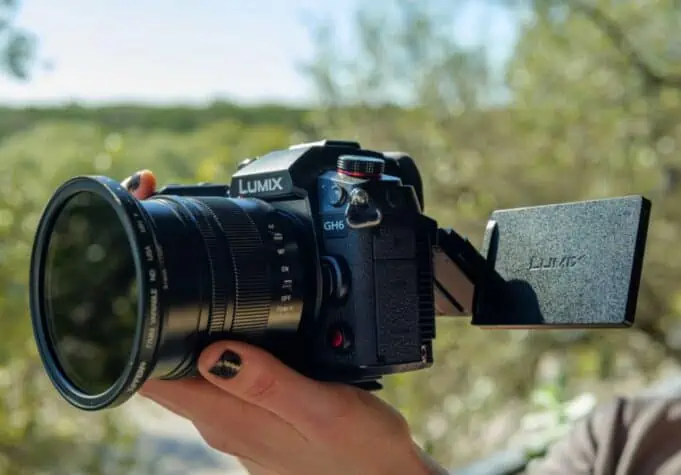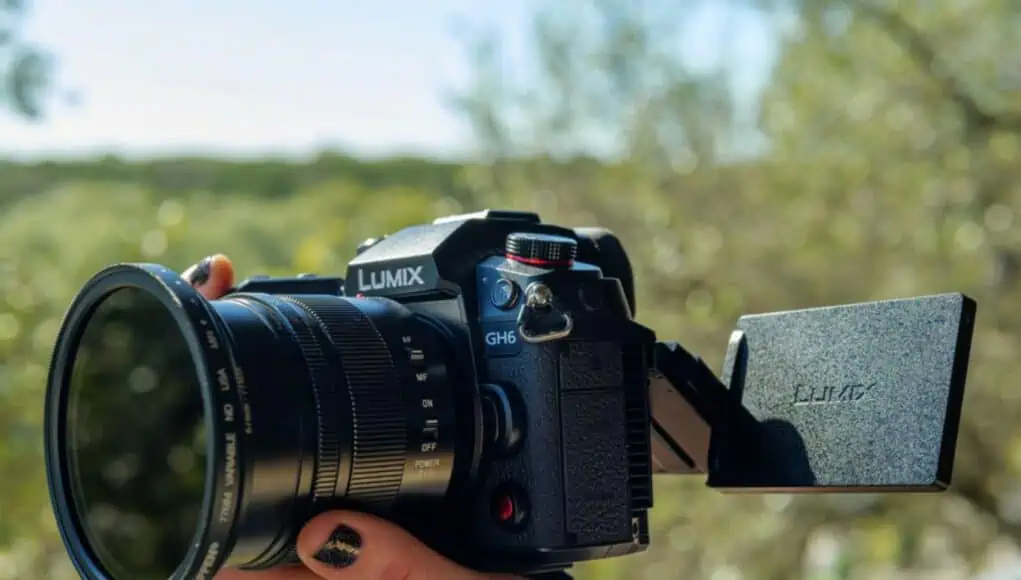Shopping or researching a mirrorless cinema camera?
These days you’re in luck. Sony, Panasonic and Fujifilm have some great new options. Content creators, wedding filmmakers, influencers, corporate video teams, and videographers of all types should be pretty excited — these three new mirrorless options are highly capable cameras, but come in at reasonable prices (especially considering inflation!).
Also, these camera bodies are quite compact relative to some of the more expensive and bulky cinema cameras. So you’ll easily be able to throw these into a travel bag and enjoy some quality video while on the road.
But, if you’re like me, three new models in particular have caught your attention:
… and the decision is a tough one. All of them are superb cameras receiving solid reviews on the video side of things.
When the pandemic hit I sold my GH5 kit knowing we would not be working in the field for a while and now that Covid has eased we’re looking to start shooting bits and pieces and experimental videos for posting here on Stark Insider.
I initially thought the choice would be obvious: GH6 all the way. After all, I spent years with the GH5. I was familiar with the controls and ergonomics and was comfortable working with the footage in Premiere. Plus, that IBIS (in-body image stabilization) is bonkers good. With handheld you can achieve near gimbal like performance. It’s really amazing. Even, as I discovered, when using manual cinema lenses such as those made by Rokinon.
However, this year along we’ve been quite spoiled when it comes to mirrorless cinema cameras. In addition to the GH6, both Sony and Fujifilm released appealing options in the FX-30 and X-2Hs. Like the GH6, both are hybrid cameras that take photos in addition to shooting video, but lean heavily on video specs making them perfect for those who like me are mostly interested in the latter.
So… which to chose? FX30 or GH6 or X-H2s?
Here’s a brief run down on my thought process and eventual pick. Almost. Well, let’s see…
Best Mirrorless Cinema Camera: Sony FX30 vs Panasonic GH6 vs Fujifilm X-H2S
(in no particular order)
Sony Fx-30

- 26.1MP APS-C BSI CMOS Sensor
- UHD 4K up to 120p
- 10-Bit 4:2:2 XAVC S-I,16-Bit Raw Output
- S-Cinetone/S-Log3/HLG, 14+ Stops DR
- Phase Detection AF/Face Tracking/Eye AF
- Standard ISO 100-32000, Dual Base ISO
- Dual CFexpress Type A/SDXC Card Slots
- Sony E-mount
- $1,798 USD
Sony surprised me with this one. Just announced, this tiny beast called the FX30 retails for $1,798 and ships soon. It looks to me to be a purpose-built mirrorless cinema camera that does have photo capabilities on the side, but is really targeting video shooters. The FX30 seems to be a a great primary camera for many videographers while also being a great option as a b-cam/crash cam for big productions invested in Sony, or renting Sony. Officially Sony even brands this model as part of its “Cinema Line” and is likely positioning it also as a stepping stone to step-up models such as the FX-30, FX9 and Venice cameras. Consequently you’ll find S-Log3 which should, in theory at least, grade the same as others in the family, meaning you’ll get a consistent image across the board — handy when color matching several cameras for a production.
In any case here’s my thoughts about the FX-30. Keep in mind this is coming from a solo operator shooting short films, experimental videos, and is not concerned at all about the photo capabilities. I don’t have crew so no focus puller, no AC, no sound person, etc. I’m looking for a lightweight camera to travel or carry around locally when I want to run-and-gun without the fuss of setting up something heavy and wieldy and less discrete such as the RED Dragon.
What I like about the FX-30:
- Tiny, tiny, tiny!
- 1/4″-20 mount points all over the place — convenient for mounting accessories such as a monitor or SSD cage
- S-Log3
- 16-bit RAW Output to the Atomos Ninja V+ recorder/monitor
- No EVF results in cleaner design and one less thing to get in the way (yes, for me that’s a benefit)
- APS-C sensor yields a FOV that approximates Super 35 — my favorite look
- Decent high speed shooting with 4K/120
- 14+ stops of dynamic range — at least, as reported by Sony
- 5-axis IBIS
- Tally lights
Things I don’t like or I’m not so sure about on the FX-30:
- Sony e-Mount — I’m a legacy Canon DSLR shooter so I have lots of Canon glass. Also, I notice a lot of Sony glass is quite pricey.
- For some silly reason there’s no 180-degree shutter setting, instead you need to use the traditional photo style setting (e.g. 1/48 for 23.98fps) — why on earth?! Every serious cine camera has the 180-degree option. I’ve been using it for years on the GH5 and RED and it’s so convenient in use that I can’t underestimate this lack of feature. ymmv.
- Lack of waveform.
- Questionable battery life per some — this doesn’t worry me too much as the batteries are small and it’s easy to carry a bunch.
- Uses the smaller, but more expensive type A CFexpress memory card (vs. the cheaper type B on the others) — might not be a big deal really as I plan to shoot 90% of the time with an Atomos Ninja V+ to capture ProRes RAW for ease of editing.
- No internal ProRes codec.
- Image quality? — will it be organic, or look too digital?
Panasonic Lumix GH6

- 25.2MP Live MOS Micro Four Thirds Sensor
- 4K 60p 4:2:2 10-Bit Unlimited Recording
- 5.7K 60p, 4K 120p HFR, FHD 300p VFR
- ProRes 422 HQ, V-Log and DR Boost
- Dual I.S. 2, 7.5-Stop 5-Axis Stabilizer
- 100MP Handheld High-Resolution Mode
- 3.68m-Dot OLED Electronic Viewfinder
- 3.0″ 1.84m-Dot Free Angle Touchscreen
- CFexpress Type B & SD UHS-II Card Slots
- MFT mount
- $2,198 USD (I notice there was a $200 price increase in the GH6 recently)
As you’d expect the GH6 is the natural successor to the GH5, and it looks the part, both on paper and aesthetically. Panasonic’s experience with the GH line has been refined to near perfection, or so it would appear in my research. This is a highly capable camera with a deep light of features. You’d get just about anything you’d want here including the best filmmaking assist tools around (waveform, vectorscope), anamorphic support, 5.7K video, 4:2:2 10-bit internal Apple ProRes, IBIS, V-Log flat picture profile, plenty of high-speed options for slow motion, and a nifty 100MP high-resolution photo mode should you need it.

I mean come on now. The GH6 looks to me to still be the one to beat. I did mention earlier this would be the natural choice for me and likely any GH4 or GH5 shooter looking to upgrade. But then again the FX30 is really slick and after the recent GH6 price increase offers tremendous capability for $400 less; something to keep in mind. One thing I never really did like about the GH5 (and it’s hard to find any faults) was the digital nature of the image quality. Even with noise reduction and sharpening dialed down I found things looking quite digital — nothing close to the incredible organic and gorgeous stuff you’d find on early Blackmagic cameras. So I’d dirty it up in post with film grain and other effects to (try to) approximate the film look I so adore. In any case I wonder if the GH6 has improved in this regard? Online footage looks quite nice. Regardless, some other thoughts below.
What I like about the GH6:
- Strong video-centric pedigree.
- Best-in-class ergonomics — everything is right where it needs to be including the WB/ISO/exposure adjust buttons to the customizable buttons to the focus switch on the back.
- Also best-in-class video assist tools. End of story.
- 180-degree shutter option. As it was! As it was!
- Internal ProRes. Awesome.
- If the IBIS is anything like the GH5 expect magic.
- Compared to FX30 uses less expensive Type B CFexpress cards (though you can use SD UHS-II v90 cards for most types of shooting).
- Micro Four Thirds mount is versatile, and the sensor offers reach thanks to the crop (a blessing or curse depending on your needs).
- Plenty of affordable lens choices — I think MFT lenses are, in general, the cheapest around. Also, they’re really small making it possible to carry a bunch of lenses to a shoot without needing several assistants to lug them around.
Things I don’t like or I’m not so sure about on the GH6:
- My biggest gripe here is the aforementioned image quality. Is it at all filmic? Or still overly digital and engineered for high-contrast/over-saturated social media feeds?
- I’d rather not have an EVF. Nit-picky I know, but it sort of gets in the way if you prefer to shoot video using monitors.
- Regarding auto-focus: I know Panasonic lags in this area, but I shoot fully manual so that’s no an issue for me. Still, I should at least not it here for those who rely on AF for v-logging or weddings, or wildlife shooting, etc. You’ll likely want to avoid the GH6 if you need reliable, speedy AF for video.
Fujifilm X-H2S

- 26.1MP APS-C X-Trans Stacked BSI Sensor
- 4K 120p, 6.2K 30p, FHD 240p 10-Bit Video
- Internal ProRes 422 HQ and F-Log 2
- 7-Stop In-Body Image Stabilization
- 5.76m-Dot OLED Electronic Viewfinder
- 3″ 1.62m-Dot Vari-Angle Touchscreen LCD
- 40 fps E. Shutter, 15 fps Mech. Shutter
- 425-Pt. Hybrid AF, AI Subject Detection
- ProRes & Blackmagic RAW via HDMI
- CFexpress Type B & SD UHS-II Card Slots
- Fujifilm X-mount
- $2,499 USD
Fujifilm has always tempted me. For whatever the reason, Fuji cameras always tend to have the best footage online. It’s almost always organic and even dreamy. In short it looks to me like cinema. Bergman! Fellini! Tarkovsky! You name it you may find that look here. As for the skill…
With the X-H2S, Fuji has modified the top plate and done away with its traditional photography dials, and in a nod to videographers implemented something more useful for shooting video. That’s very welcome and makes the X-H2S a really serious hybrid option. Specs-wise everything seems in order: flippy screen, 4K/120, internal ProRes, IBIS, full-size HDMI connector (like the other two above), excellent AF, external ProRes RAW. When it comes to shooting video for Stark Insider, Fujifilm is the one I have the least experience (just a X-T3 rental years ago). I have shot a lot on the GH5 as well as Sony (a6000, a6500, a7 III) and lots of Canon DSLR (60D/70D/80D). So the world of Fuji is a bit foreign to me. Nevertheless, the X-H2S seems to be a compelling option.
What I like about the X-H2S:
- Image quality.
- Beautiful design and overall look of the body — not sure that’s really important in the grand scheme I admit.
- Handy LCD on top plate with key information read-out (shutter, f-stop, ISO, etc.).
- Internal ProRes with external ProRes RAW option.
- Per dpreview, the X-H2S has the best rolling shutter (5.2ms in UHD 24fps) when compared to the GH6 and FX-30 — this might not be as important as it seems if you’re not doing whip pans or tracking fast moving objects.
- Light camera body (660g).
- APS-C sensor.
- Battery life is reportedly quite good.
Things I don’t like or I’m not so sure about on the X-H2S:
- The controls — granted I haven’t held or shot with an X-H2S, but I feel like the dials and buttons aren’t as intuitive as the GH6. Someone could likely prove me wrong here. And I admit as a former GH5 shooter I have some bias no doubt, yet I just feel like the GH5 was perfect in the handling department (and that the GH6 is too).
- It’s expensive — at $2,499 the X-H2S is a lot more expensive than the FX30 and also somewhat more expensive than the GH6. Yes, you get an incredible stills camera, plus outstanding video. In my case, I don’t care much at all for the photo features so I’d rather not foot the bill for something I won’t use. Again: ymmv.
- The X-mount is my least favorite of the bunch.
Other Mirrorless Camera Options for Video Shooters
Obviously there’s other choices out there.
You may also want to consider mirrorless bodies such as the OM System OM-1 (Olympus), the full-frame Sony FX3, Canon EOS R10 or R6, among so many more. Even the overlooked full-frame Sigma fp seems like an intriguing consideration for those shopping for a cinema pure play. And when talking about this category we can’t fail to mention the popular Sony Alpha a7 III, also priced similarly to its rivals.
I shortlisted the FX30, GH6 and X-H2S because they are the most appealing options for me, and all come in relatively close in price and features.
Also, let’s not forget the phone in your pocket or purse. Be it an Android or iPhone chances are it will shoot pretty good video, and, in the case of the iPhone Pro models, outstanding video. In my experience, though, shooting on a phone has downsides including an overly sharpened and crappy looking image quality when it comes to film approximation (man I love that term it seems). Then there’s the fact you need to fill up your phone’s internal memory with footage and copy it over using a cable. A pain compared to using removable media. For content creators and influencers none of this will be a problem as quickly shooting video, editing it (in phone) and uploading it to YouTube and Instagram and TikTok will be the ultimate priority — and a phone will be unbeatable in that use case. I digress.
Choosing a Winner: Sony FX-30 vs. Panasonic Lumix GH6 vs. Fujifilm X-H2S

The winner: Panasonic GH6.
I just can’t deny the overall package of greatness that Panasonic has put together with the GH6. You may not shoot anamorphic today, but isn’t it nice to know the feature is there if you want to experiment in the future? And Panasonic just gets all the basics right. Grip the camera and use it to shoot some video projects and you’ll quickly appreciate the ergonomics. Try some IBIS and you may not even need that bulky gimbal on your next shoot.
Concern for the MFT mount/sensor? Forget all that. Bro, that ain’t going to make or break you. What matters most is all the things I haven’t mentioned here including lighting, camera movement, set design, story/script, blocking and all the stuff that makes, as they say, the mise en scène. So let’s not forget the camera is a tool. Just a basic tool. Any concern over MFT is just clickbait and wasted forum talk. It produces an image. You can attach a lens. You can hit record. You can record a movie. Voila!
Now, you could make an argument for any of these cameras and prove me wrong a million different ways.
For those invested in Sony gear, the FX30 is a no-brainer. It’s phenomenal at a price that is almost too-good-to-be-true. Slam dunk.
For those who want both quality photos and quality video without compromise, well it’s darn near impossible to beat the APS-C-based Fujifilm X-H2S. Amazing stuff.
For me, though, the GH6 is through-and-through the killer package for us video shooters. I’ll admit I did pre-order the FX30 and still have not cancelled it. My ultimate choice did indeed wind down to the Panasonic or the Sony. A really tough call. In the end my positive experience over the years with the GH5 surely tilted the playing field.
Needless to say this is far from an exhaustive comparison and represents one person’s experience. I highly recommend you go dig deeper if need be. Places like dpreview.com and Newsshooter have loads of detailed content on all three of these cameras.
Meanwhile, I should stop writing this post now, and switch gears and finish story-boarding that Stark Insider perfume commercial project I’ve been working on…


